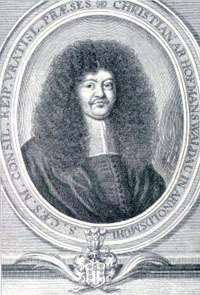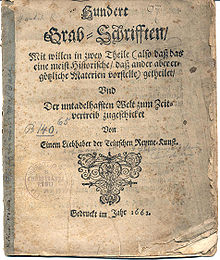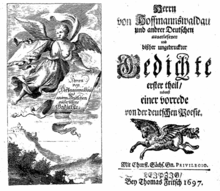Christian Hoffmann von Hoffmannswaldau
Christian Hoffmann von Hoffmannswaldau (also: Hofmann von Hofmannswaldau , baptized December 25, 1616 in Breslau , Principality of Breslau ; † April 18, 1679 ibid) was a Silesian poet and epigrammatist , mayor of the city of Breslau, governor of the principality of Wroclaw and director of Burglehns Namslau . He is considered to be the leading representative of the Second Silesian (poet) school and the founder of the “ gallant style ” in German-language poetry.
Life
Hoffmann belonged to a "young" patrician family from Breslau , who first came to Breslau via Glatz in the 16th century, originally from Neisse . The progenitor of the family was George Hoffmann († 1583), pastor of Wünschelburg , assessor and senior of the consistory of the County of Glatz .
origin
Christian Hoffmann von Hoffmannswaldau was the son of Johannes Hoffmann ( Greek : Auleander ) (1575-1652), who had moved from Wünschelburg to Breslau, and his first wife Anna Nagel (1591-1621) from Breslau. As a civil servant at the War Pay Office in Vienna on September 11, 1612 in Prague, the father was raised to the hereditary- Austrian nobility and received on July 13, 1629 in Vienna, as Imperial Councilor and Chamber Secretary in Wroclaw, the imperial nobility confirmation with the predicate "von Hoffmannswaldau". After the death of his first wife, father Johannes married Magdalene Hogel († 1627) in second marriage on October 25, 1622 and after her death in third marriage Maria von Artzat (1588–1662) from Breslau. Father Hoffmann already wrote Latin verses.
Career
After attending the Elisabeth Gymnasium in Breslau , Hoffmann switched to the Academic Gymnasium in Danzig in 1636 . There he often met with Martin Opitz , who was supposed to have a lasting influence on Hoffmann's poetic work. On October 9, 1638, he was at the University of Leiden ( Netherlands ) enrolled and studied law . He met Andreas Gryphius in Amsterdam on a long educational trip that was common at the time as the companion of a prince's son Frémonville . Then he went to England , where he learned the language, and then to France , where he met with important scholars such as Hugo Grotius (1583–1645), François Auguste de Thou (1606–1642), Denis Pétau (also Dionysius Petavius , 1583– 1652) and others. In Italy he stayed for a long time in Genoa , Pisa and Siena , traveled on to Rome and returned to Breslau via Florence , Bologna , Venice and Vienna in 1642.
Promotion in Wroclaw

Under paternal pressure, Hoffmann married Marie on February 16, 1643 (baptized July 3, 1626 in Breslau; † October 19, 1692 probably there), the daughter of Simon Webersky, who on September 1, 1660 was raised to the nobility with the title von Webersickh has been. The sons Johann (Hans) Christian (1644–1724) and Georg Moritz came from the marriage. Hoffmann was a successful businessman in Breslau, made large fortunes and became the landowner of Arnoldsmühle, Belkau and Schlaupe in the Principality of Breslau and Kutscheborwitz in the Principality of Wohlau .
In 1647, shortly before the end of the Thirty Years' War , Hoffmann was, for particularly because of his worldly education and broad knowledge of European literature, although he did not belong to the otherwise represented in the Council-old merchant and patrician families Council aldermen elected. He was a member of the Breslau Council without interruption for 32 years until his death in 1679 - alternately as aldermen or consul. In 1670 and 1674 he was lay judge , 1671–1673, 1675 and 1676 second consul and thus deputy council president and governor. From 1677 until his death he was council president and thus mayor of the city of Wroclaw and governor of the principality of Wroclaw. During his tenure he traveled because of sectarian conflict in 1657 to the imperial court of Vienna , where he was very successful, which was appointed him Imperial Council by Emperor Leopold I earned. He also stayed in Vienna for negotiations in 1660, 1669 and 1670.
Cultural life
Hoffmann enjoyed an excellent reputation in Breslau and contributed to the cultural life of his hometown through events in his home. Due to later professional and diplomatic obligations as a member of the Breslau council, he wrote only a few works from 1647. Most of his literary works were created in the 1640s.
plant
Hoffmann wrote sayings and wrote a large number of religious and secular songs , but also left behind some extensive works, including above all: The faithful Schäffer (1652), a translation of Giovanni Battista Guarini's Il pastor fido , and the Heldenbriefe from 1664, one fictional correspondence inspired by Ovid's heroids .
Contemplative themes and heroic figures play a major role in his poetry, but also a “traveling Cupid ” or Venus between a triumphal chariot and a pretty girl's face. He preferred the iambi (for example: “So should the purple of your lips / Is it the bite of my freedom?”); his style is characterized by the accumulation of linguistic images.
Hoffmann was a famous poet during his lifetime, but did not publish his works himself. His verses were printed without authorization, for example the grave writings of 1662; they went from hand to hand, were also repeatedly copied and even reached the rulers' courts. Since his verses also appeared distorted, Hoffmann saw himself compelled in 1679 to prepare a selection of his works himself under the title: "German Translations and Texts" for printing, which he did not live to see.
reception
What came to the public after his death in the authorized edition of the German translations and poems comprised only about half of his complete works and appeared in an already edited form. Nevertheless, this edition established a new style in German literature, the so-called "gallant epoch". In a posthumous speech of praise by Daniel Caspar von Lohenstein's friend from Breslau to Christian Hoffmann von Hoffmannswaldau, his poetry is characterized as being inspired by Italy and claims that Opitz took over this "Welsche" from Hoffmann.
The poet's fame reached a climax when Benjamin Neukirch published the first major German anthology in 1695 under the title Herr von Hoffmannswaldau and other German ... poems . The popularity of his poetry also led to the attribution of lascivious and obscene verses written by strangers to him. This is how the vaunted Hoffmann became a reviled poet. But the importance of his formal art remained undisputed.
Works
(Selection)
- Hundred grave writings , o. O. 1662 grave inscriptions 1662 digitized and full text in the German text archive
- Play-sensual dying thoughts , 1663
- Curious hero letters and other wonderful poems , 1673
- Der Getreue Schäffer (translation of Guarini's “Pastor Fido”), 1678
- German translations and poems (including dying Socrates, heroic letters, poetic history, wedding poems, mixed poems, burial poems, spiritual odes, poetic tombstones), 1679–1727
-
Benjamin Neukirch (Ed.): Lord von Hoffmannswaldau and other Germans of exquisite and bit unprinted poems . Fritsch, Leipzig 1695ff .; - (new ed. by A. George de Carpua and EA Phillipson, Tübingen 1961.)
- Volume 1 from 1695, alongside a preface from German poetry. Fritsch, Leipzig 1695 Digitized and full text in the German text archive
- Volume 1 from 1697: Digitized edition of the University and State Library Düsseldorf
- Volume 2 from 1697: Digitized and full text in the German Text Archive , digitized edition of the University and State Library Düsseldorf
- Volume 3 from 1703: digitized version and full text in the German text archive
- Volume 3 from 1710: Digitized edition of the University and State Library Düsseldorf
- Volume 4 from 1708: Digitized edition of the University and State Library Düsseldorf
- Volume 5 from 1710: Digitized edition of the University and State Library Düsseldorf
- Volume 6 from 1709: Digitized edition of the University and State Library Düsseldorf
- Speech exercises. In addition to the accompanying letters of praise from distinguished persons , 1702
-
Franz Heiduk (ed.): Collected works . (Three-part work), Georg Olms Verlag , DNB 551036362
- German translations and dishes . Volume 1, part 1. Georg Olms Verlag, Hildesheim 1984, ISBN 3-487-07445-1 .
- German translations and dishes . Volume 1, part 2. Georg Olms Verlag, Hildesheim 1984, ISBN 3-487-07446-X .
- Curriculum studiorum and other printed works . Volume 2. Georg Olms Verlag, Hildesheim 1993, ISBN 3-487-09376-6 .
literature
- Gerhard Dünnhaupt : Christian Hoffmann von Hoffmannswaldau (1616–1679) , in: Personalbibliographien zu den Druck des Barock , Vol. 3. Hiersemann, Stuttgart 1991, ISBN 3-7772-9105-6 , pp. 2123-2150.
- Franz Heiduk : The family of Hoffmann von Hoffmannswaldau . In: Schlesien 13 (1968), pp. 36-39.
- Franz Heiduk: The date of birth of Christian Hoffmann von Hoffmannswaldau . In: Alfons Hayduk (Ed.): Schlesische Studien , S. 118f., Verlag Delp, Munich 1970, ISBN 3-7689-0063-0
- Franz Heiduk: Hoffmannswaldau and the tradition of his works. A critical investigation with the imprint of two previously unknown poems as well as a complete list of the manuscripts and first works . In: Yearbook of the Free German Hochstift 1975, pp. 1–75.
- Stefan Kiedrón: Christian Hofman von Hofmanswaldau and his “Dutch world” . ATUT, Wrocław and Neisse-Verlag, Dresden 2007
- Eberhard Mannack: Christian Hoffmann von Hoffmannswaldau , in: Gunter E. Grimm, Frank Rainer Max (Hrsg.): German poets, life - work - effect, volume 2 (Reformation, Renaissance and Baroque), page 251f., Verlag Reclam, Stuttgart -Ditzingen 1988, ISBN 3-15-008612-4
- Volker Meid : Christian Hoffmann von Hoffmannswaldau . In: Metzler Authors Lexicon , Stuttgart 1986; Pp. 289-290
- Lothar Noack: Christian Hoffmann von Hoffmannswaldau (1616-1679), life and work , Verlag Niemeyer, Munich 1999, ISBN 3-484-36551-X
- Hermann Palm: Hofmann von Hofmannswaldau, Christian . In: Allgemeine Deutsche Biographie (ADB). Volume 12, Duncker & Humblot, Leipzig 1880, pp. 639-642.
- Oskar Pusch : The Breslau city councils in the period from 1241 to 1741 , Volume 2, page 271, in: Johannes Hoffmann (Ed.): Publications of the Research Center for East Central Europe at the University of Dortmund , Series B No. 35, Dortmund 1987, ISBN 3-923293-20-8 , ISSN 0931-5306
- Erwin Rotermund : Christian Hofmann von Hofmannswaldau , Stuttgart 1963 (= Metzler Collection 29).
- Erwin Rotermund: Affect and Artistry. Studies on the portrayal of passion and the method of argumentation at Hofmann von Hofmannswaldau , Munich 1972.
- Erwin Rotermund: Hofmann von Hofmannswaldau, Christian. In: New German Biography (NDB). Volume 9, Duncker & Humblot, Berlin 1972, ISBN 3-428-00190-7 , pp. 462-464 ( digitized version ).
- Rudolf Stein: The council and the council families of old Breslau , Göttingen working group (ed.), Publication no.273, Holzner-Verlag, Würzburg 1963
- Genealogical manual of the nobility . Nobility Lexicon . Volume V (Volume 84 of the complete series). CA Starke Verlag, Limburg (Lahn) 1984, ISSN 0435-2408 .
- [Entry] Christian Hoffmann von Hoffmannswaldau. In: Heinz Ludwig Arnold (Hrsg.): Kindlers Literatur Lexikon . 3rd, completely revised edition. 18 vols. Metzler, Stuttgart / Weimar 2009, ISBN 978-3-476-04000-8 , vol. 7, pp. 560-562 [Biogram, summary of the lyric work of Hans-Joachim Jakob]
- Christian Wagenknecht : Memento mori and carpe diem. To Hoffmannswaldau's sonnet the transience of beauty. Uwe K. Ketelsen : "Love binds gold and steel and yarn to white Seyde". To Hoffmannswaldau's erotic song "So should the purple of your lips." Urs Herzog : "Look further". To Hoffmannswaldau's "Die Welt". In: Volker Meid (Ed.): Poems and interpretations. Vol. 1: Renaissance and Baroque. (= RUB . No. 7890). Reclam, Stuttgart 2000 [first 1982], ISBN 978-3-15-007890-7 , pp. 332-344, pp. 346-355, pp. 357-3365.
Web links
- Publications by and about Christian Hoffmann von Hoffmannswaldau in VD 17 .
- Literature by and about Christian Hoffmann von Hoffmannswaldau in the catalog of the German National Library
- Works by and about Christian Hoffmann von Hoffmannswaldau in the German Digital Library
- Works by Christian Hoffmann von Hoffmannswaldau in the Gutenberg-DE project
- Works by Christian Hoffmann von Hoffmannswaldau at Zeno.org .
- Digitized prints by Christian Hoffmann von Hoffmannswaldau in the catalog of the Herzog August Library
- Literature list in the online catalog of the Berlin State Library
- life and work
- Hoffmann von Hoffmannswaldau: Love and curriculum vitae of Peter Abelards and Heloißen ( Memento from April 28, 2010 in the Internet Archive )
Remarks
- ↑ In the 17th century there was no uniform spelling of names, but genealogical sources name the name with a double f. See: Pusch; Heiduk; Stone; GHdA nobility lexicon
- ↑ December 25, 1617 is incorrectly mentioned in some literature as the date of birth , but it is verifiably only the date of the baptism in the Maria Magdalenen Church in Breslau. The date of birth is not known. See Heiduk
- ↑ See Stein
- ↑ Meid p. 289
- ↑ see: Transience of Beauty
| personal data | |
|---|---|
| SURNAME | Hoffmann von Hoffmannswaldau, Christian |
| ALTERNATIVE NAMES | Hofmann von Hofmannswaldau, Christian |
| BRIEF DESCRIPTION | German-Silesian poet and epigrammatist, politician and diplomat |
| DATE OF BIRTH | baptized December 25, 1616 |
| PLACE OF BIRTH | Breslau , Principality of Breslau |
| DATE OF DEATH | April 18, 1679 |
| Place of death | Wroclaw |




